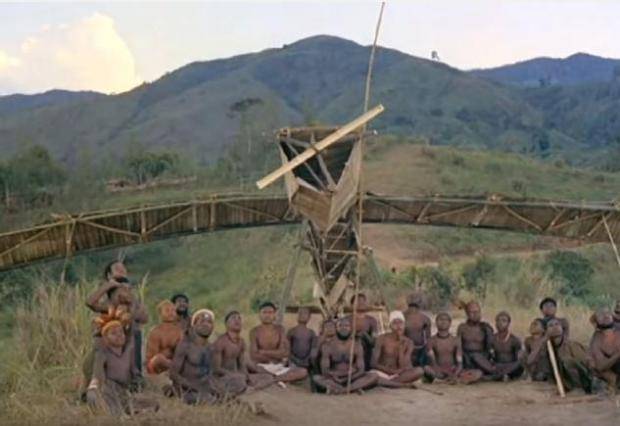During World War II, the U.S. Military stationed forces on some islands in the Pacific ocean. They kept military equipment and supplies on these islands, and built makeshift runways for planes to land and take off.
Interestingly, the military personnel found indigenous people living on those islands that had not previously made any contact with the outside world. After receiving a supply drop, the soldiers would share some of it with the natives.
All of a sudden, these tribes had access to modern medicine, clothes, canned food, tents and all kinds of life improving goods.
When the war ended, the military forces left the islands and the supply drops stopped.
The natives, wanting the deliveries to resume, built straw airports and planes. They worshipped unspecific Americans named “John Frum” and “Tom Navy”, who they believed were gods that would bring all the good stuff again.
A straw plane built by the inhabitants of one of the islands
This might all seem a little ridiculous to us, since we have a more accurate understanding of what it takes to make the supply drops happen. We know cargo doesn’t just drop out of the sky — it takes planning, people, machines, and dozens of manufacturing and transportation processes.
But if your only experience of receiving cargo is watching a bunch of pale skinned guys wave a couple of sticks just before a metal bird comes flying in with it, then it’s completely rational to build straw planes and wave around a couple of tree brunches to imitate what you think was happening.
The thing is, cargo cults like these don’t just exist in the Pacific islands. It’s all around us.
It occurs in a business that tries to copy the tactics of another business without understanding where it fits in the grand strategy of the latter.
It occurs when a programmer copies the code of a successful application, believing that the mere presence of the “winning” code will make his application successful too.
It’s the same when someone imitates a trading strategy without understanding the logic or big picture behind it.
So here’s a suggestion: Examine every aspect of your trading strategy. Do you know exactly why each component is there, and the purpose it serves? Why does the strategy trade this way instead of the opposite manner? Why are the entry, stop loss and profit target criteria set in that way?
The more you understand the ‘whys’ of your strategy, the more likely you are to know what you’re doing.


This is amazing information and illustration for me, a strategy that one understand makes all the difference. Thanks for an amazing article.